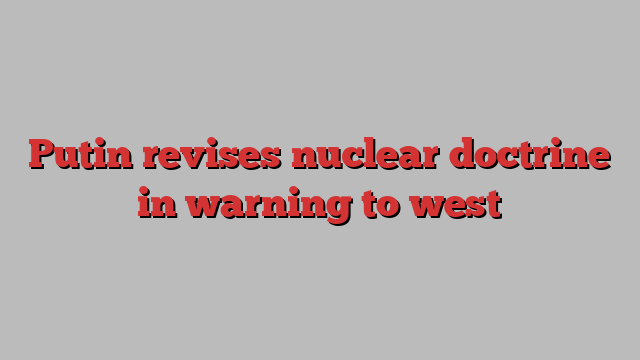
Stay informed with free updates
Simply sign up to the War in Ukraine myFT Digest — delivered directly to your inbox.
Vladimir Putin has issued a stark threat to Ukraine’s Nato allies, saying he would expand Russia’s nuclear doctrine to potentially cover attacks against his country using advanced western missiles.
Speaking to his security council on Wednesday, Putin said he would deem nuclear powers to have attacked Russia if they “participated in or supported [ . . . ] aggression” by a country using conventional weapons against them.
Putin’s threats were a clear message to Ukraine’s western allies as the US and UK deliberate letting Kyiv hit targets deep inside Russia with western-made Storm Shadow missiles.
Though Putin said Russia could respond to a conventional attack with nuclear weapons, he did not say whether it would do so if hit by the western missiles. He also did not specify which countries could be targets for Moscow’s retaliation.
But the threats, which are expected to be codified in Russian doctrine, were among the most direct the president has made to use nuclear weapons since announcing the invasion of Ukraine in February of 2022.
The changes could mark a significant lowering of Russia’s declared nuclear threshold and spell out more criteria for Russia to potentially authorise nuclear strikes, experts said.
Putin said that Russia could use nuclear weapons after receiving “reliable information” about a massed aerial assault by aircraft, missiles, and drones. Moscow would also consider an attack against its ally Belarus to be an attack on Russia itself and could defend it with nuclear weapons.
Russia’s current nuclear doctrine, last updated in 2020, allows for the use of nuclear weapons in response to an enemy nuclear first strike, or if the state’s existence is critically threatened during a conventional attack.
The US, UK, and France — Nato’s three nuclear powers — are considering requests from Ukraine to use Storm Shadow missiles to hit targets deep inside Russia.
US President Joe Biden said on Sunday that he had not decided whether to let Ukraine use the missiles, which are made by the UK and France but use US guiding technology, for strikes against Russian air bases, ammunitions depots, and command and control centres.
Putin has previously warned the US and other Nato countries against allowing Ukraine to hit Russian targets with Storm Shadows, which he said would mean Russia and Nato would be at war.
“These are signals for now, but they are pretty aggressive and the most specific ones so far,” said Alexander Gabuev, director of the Carnegie Russia Eurasia Center in Berlin.
If Russia published an updated doctrine with Putin’s proposed changes, it would still remain deliberately vague about the Kremlin’s threshold for retaliation and what its response would be, Gabuev said.
Major issues from the Ukraine war would also still be open to interpretation, such as whether Russia would consider attacks on the five Ukrainian provinces it partially occupies as assaults on its mainland.
“We’ll have to see how far they’re willing to go in the document, but this is much more muscular and specific than just saying ‘Let the whole world go to hell’,” Gabuev added.